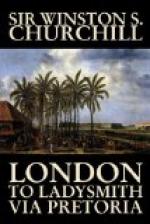Sometimes we get a little fillip of excitement. One evening, as I was leaning over the railings, more than forty yards from the nearest sentry, a short man with a red moustache walked quickly down the street, followed by two colley dogs. As he passed, but without altering his pace in the slightest, or even looking towards me, he said quite distinctly ‘Methuen beat the Boers to hell at Belmont.’ That night the air seemed cooler and the courtyard larger. Already we imagined the Republics collapsing and the bayonets of the Queen’s Guards in the streets of Pretoria. Next day I talked to the War Secretary. I had made a large map upon the wall and followed the course of the war as far as possible by making squares of red and green paper to represent the various columns. I said: ’What about Methuen? He has beaten you at Belmont. Now he should be across the Modder. In a few days he will relieve Kimberley.’ De Souza shrugged his shoulders. ‘Who can tell?’ he replied; ‘but,’ he put his finger on the map, ’there stands old Piet Cronje in a position called Scholz Nek, and we don’t think Methuen will ever get past him.’ The event justified his words, and the battle which we call Magersfontein (and ought to call ‘Maasfontayne’) the Boers call Scholz Nek.
Long, dull, and profitless were the days. I could not write, for the ink seemed to dry upon the pen. I could not read with any perseverance, and during the whole month I was locked up, I only completed Carlyle’s ‘History of Frederick the Great’ and Mill’s ‘Essay on Liberty,’ neither of which satisfied my peevish expectations. When at last the sun sank behind the fort upon the hill and twilight marked the end of another wretched day, I used to walk up and down the courtyard looking reflectively at the dirty, unkempt ‘zarps’ who stood on guard, racking my brains to find some way, by force or fraud, by steel or gold, of regaining my freedom. Little did these Transvaal Policemen think, as they leaned on their rifles, smoking and watching the ‘tame officers,’ of the dark schemes of which they were the object, or of the peril in which they would stand but for the difficulties that lay beyond the wall. For we would have made short work of them and their weapons any misty night could we but have seen our way clear after that.
As the darkness thickened, the electric lamps were switched on and the whole courtyard turned blue-white with black velvet shadows. Then the bell clanged, and we crowded again into the stifling dining hall for the last tasteless meal of the barren day. The same miserable stories were told again and again—Colonel Moller’s surrender after Talana Hill, and the white flag at Nicholson’s Nek—until I knew how the others came to Pretoria as well as I knew my own story.
‘We never realised what had happened until we were actually prisoners,’ said the officers of the Dublin Fusiliers Mounted Infantry, who had been captured with Colonel Moller on October 20. ’The “cease fire” sounded: no one knew what had happened. Then we were ordered to form up at the farmhouse, and there we found Boers, who told us to lay down our arms: we were delivered into their hands and never even allowed to have a gallop for freedom. But wait for the Court of Inquiry.’




